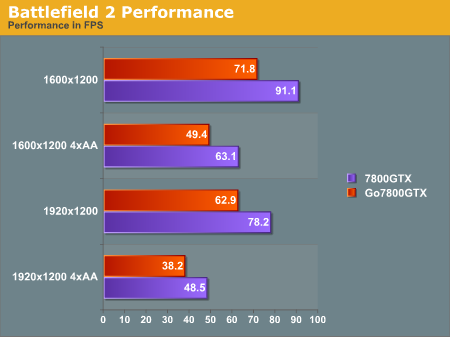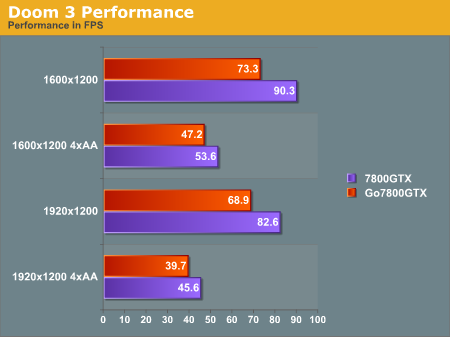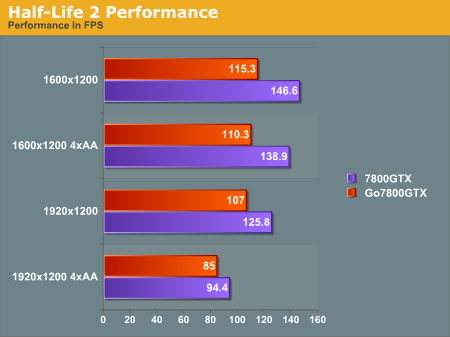Hypersonic Aviator EX7: NVIDIA GeForce Go 7800 GTX First Look
by Josh Venning on October 10, 2005 9:30 AM EST- Posted in
- GPUs
Performance Tests
Because we weren't able to physically take the Go 7800 GTX and put it into our desktop system, we can't really compare the laptop and desktop version of the 7800 GTX directly. Instead, we performed tests with the Hypersonic system and compared these numbers with tests from a desktop setup fitted with a normal 7800 GTX.
Since the two systems have differences other than the graphics card (i.e. system RAM, processor speed, processor type, etc.), there will be some variation here, but we can still get a general idea of how well the Go 7800 GTX performs compared to the desktop version. Especially at higher resolutions, we will become more GPU limited than CPU/system limited. With our desktop system using an AMD Athlon 64 FX-55 rather than an Intel part, we can definitely expect that the numbers will favor the desktop system.
When looking at the comparison of the stock 7800 GTX and the Go 7800 GTX, keep in mind that the drop in core clock speed is almost 10% and the drop in memory clock is also almost 10%.



While there is variation between the two systems, the differences that you see in framerates are in large part due to the difference in the clock speeds of the 7800 GTXs. You can see from the graphs that for the most part, the difference in framerates between systems are consistent, with the exception of Half life 2, which isn't too surprising given the fact that it's a little more CPU limited than the other 2 games.
In Battlefield 2, we see about a 20%-23% decrease in performance with the Go 7800 in each of the settings. Half life 2 sees about a 22% decrease in performance at 1600x1200 with and without AA, but only a 15% decrease at 1920x1200 without AA, and about 10% at the same resolution with AA. Doom 3 decreases in performance with AA enabled at both resolutions by around 12% on the Go 7800 GTX, and around 18% without AA.
Overall, Battlefield 2 did the worst of these three games on the Hypersonic system, but even at 1920x1200 with 4x AA enabled, it still achieved 38.2 fps, which is playable. Most gamers wouldn't be too upset about either turning off AA at that resolution or going down in resolution (especially if in a notebook with a smaller panel). Doom 3 is only slightly better with 4xAA, while Half-Life 2 has no trouble at all with AA enabled at 1920x1200 resolution.
The bottom line is you do sacrifice some performance going with the mobile 7800 GTX instead of the standard one, but not an incredible amount. Again, we're talking about a notebook here and this one surpasses most great gaming desktops, truly earning the label of a "desktop replacement".
Because we weren't able to physically take the Go 7800 GTX and put it into our desktop system, we can't really compare the laptop and desktop version of the 7800 GTX directly. Instead, we performed tests with the Hypersonic system and compared these numbers with tests from a desktop setup fitted with a normal 7800 GTX.
Since the two systems have differences other than the graphics card (i.e. system RAM, processor speed, processor type, etc.), there will be some variation here, but we can still get a general idea of how well the Go 7800 GTX performs compared to the desktop version. Especially at higher resolutions, we will become more GPU limited than CPU/system limited. With our desktop system using an AMD Athlon 64 FX-55 rather than an Intel part, we can definitely expect that the numbers will favor the desktop system.
When looking at the comparison of the stock 7800 GTX and the Go 7800 GTX, keep in mind that the drop in core clock speed is almost 10% and the drop in memory clock is also almost 10%.



While there is variation between the two systems, the differences that you see in framerates are in large part due to the difference in the clock speeds of the 7800 GTXs. You can see from the graphs that for the most part, the difference in framerates between systems are consistent, with the exception of Half life 2, which isn't too surprising given the fact that it's a little more CPU limited than the other 2 games.
In Battlefield 2, we see about a 20%-23% decrease in performance with the Go 7800 in each of the settings. Half life 2 sees about a 22% decrease in performance at 1600x1200 with and without AA, but only a 15% decrease at 1920x1200 without AA, and about 10% at the same resolution with AA. Doom 3 decreases in performance with AA enabled at both resolutions by around 12% on the Go 7800 GTX, and around 18% without AA.
Overall, Battlefield 2 did the worst of these three games on the Hypersonic system, but even at 1920x1200 with 4x AA enabled, it still achieved 38.2 fps, which is playable. Most gamers wouldn't be too upset about either turning off AA at that resolution or going down in resolution (especially if in a notebook with a smaller panel). Doom 3 is only slightly better with 4xAA, while Half-Life 2 has no trouble at all with AA enabled at 1920x1200 resolution.
The bottom line is you do sacrifice some performance going with the mobile 7800 GTX instead of the standard one, but not an incredible amount. Again, we're talking about a notebook here and this one surpasses most great gaming desktops, truly earning the label of a "desktop replacement".










52 Comments
View All Comments
Degrador - Monday, October 10, 2005 - link
Yes, they are meant to be testing graphics. As you say, they should be minimizing the impact any of the other system components have on the results. Hence my point of why not keep the cpu and the memory the same - whether it's 1GB or 2GB, equal memory would make the results more applicable to finding the difference between the chips.Johnmcl7 - Monday, October 10, 2005 - link
I fully agree - the review appears to be aimed at comparing the desktop 7800 to the mobile 7800, not the notebook as a whole against powerful desktop. If it was a Pentium-m system I can appreciate it's more difficult to match a desktop system but using an FX-55 against a P4 670 makes the performance figures almost useless, we have no idea if the performance differences are due to the faster processor or differences in the 7800.John
bob661 - Monday, October 10, 2005 - link
I disagree. Although the 3.8 is slower than a FX-55, neither video cards would be CPU bound in those systems. And the difference in memory sizes doesn't have that great of an effect on performance.Johnmcl7 - Tuesday, October 11, 2005 - link
The comments on the benchmark seem to imply AT are comparing the 7800s, not a complete system. If the latter was their intention, the review should have been written to reflect this.John
bpt8056 - Monday, October 10, 2005 - link
This is a high-end notebook and it should be compared against a high-end desktop system. While it may not be a good indicator of raw graphics power, it does show what you'll get with this notebook compared to an uber-fast desktop system. Frankly, I'm impressed with the numbers that the GeForce Go 7800GTX put out in a system with obvious limitations.DerekWilson - Monday, October 10, 2005 - link
This was our take on comparing the systems -- gamers will really want to know if a notebook will be able to perform as well as the highest end desktops. The tradeoff in performance is important even if mobility is helpful. That's a lot of money to drop on a notebook, and I could build our desktop box for much less.
The point is this: just because it's got a desktop processor and a Go 7800 GTX does not mean it will perform the same as the highest end desktops out there.
Note that this was also billed as a first look.
timmiser - Tuesday, October 11, 2005 - link
"gamers will really want to know if a notebook will be able to perform as well as the h1ighest end desktops."Well, judging by the number of complaints I would say you're out of touch with your audience! Gamers already know that a high end desktop will be faster than a high end laptop. Give us a little credit please!
ElFenix - Monday, October 10, 2005 - link
i agree. i've always thought there are two ways to go about making a review fair: use as similar components as you can, other than the one being tested, and get as similar a price out of each setup as you can. obviously, these types of notebooks cost probably as much as a high end desktop, so i think this comparison is fair and give you a good idea of what you give up if you choose to spend $2500+ on a portable rather than a desktop. of course, the portable is portable, so has all those benefits.a thought for portable/notebook reviews: a subjective review on using the system to take notes in class (on a little college desk), lugging around campus (whether it fits in backpacks, lockers, etc), that sort of thing.
yacoub - Monday, October 10, 2005 - link
Well there are two reviews much more useful that AT will hopefully conduct with this laptop soon:*Comparison against the previous desktop replacement gaming laptop which I believe sported some sort of high-end ATI Mobile GPU. This shows how it compares to what else is up for comparison to potential buyers. Let's see just how much this new GPU boosts performance versus the previous champions.
*Comparison with a desktop with the same CPU, RAM count, and a real 7800GTX, to get a better idea how much performance is lost if someone goes with a laptop instead of a desktop for their next upgrade. Let's see just how much performance is lost and price is increased for the same parts in a laptop, because it's a joke how much they charge for those things. (okay the last bit is just my opinion.)
Warder45 - Monday, October 10, 2005 - link
I have to agree. When I saw the desktop system I didn't understand what the point of the comparison would be. Also why not wait to throw the Dell machine in? Then compare the differences between the two, with heat, speed, and battery life.